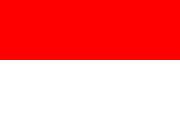Kesatuan Melayu Muda
Young Malays Union Kesatuan Melayu Muda كساتوان ملايو مودا | |
|---|---|
| Abbreviation | Kesatuan Melayu Muda |
Left-wing | |
| Colours | Red, white |
| Party flag | |
 | |
| This article is part of a series on the |
| Politics of Malaysia |
|---|
 |
Kesatuan Melayu Muda (KMM) (Jawi: كساتوان ملايو مودا ; "Young Malays Union" in Malay) was the first leftist and national political establishment in British Malaya.[4] Founded by Ibrahim Yaacob and Ishak Haji Muhammad, KMM grew into a prominent pre-war nationalist movement, notable for its leftist political stance and willingness to use violence, a sharp break with their contemporaries in the Malay nationalist movement.
The KMM, however, commanded very little mass support. By 1945, it only enjoyed a membership of 60 and limited to a few cities. In addition, their radical anti-colonialism was anathema to British authorities which had Ibrahim and other KMM leaders arrested in 1942. After
Foundation and Development
Broadly speaking, the intellectual basis for what was to become developed both from external impetus from the spread of Indonesian nationalist ideas into Malaysia, and the development of an anti- colonialist intellectual climate within the Sultan Idris Training College for Malay Teachers. In 1927, Malay nationalism in British Malaya received intellectual impetus from their Indonesian cousins in the wake of the failed 1926 Communist uprising against the Dutch in the Dutch East Indies. Indonesian nationalist leaders, such as the Comintern agent Tan Malaka, sought refuge in Malaya in the wake of the crackdown that ensued, where they spread their radical anti-colonial ideology to Malaya.
This was a significant development in Malay nationalism, given that the nationalism that had developed in Malaya, in contrast to the movements developing in the other British colonial possessions of India and Burma, remained relatively placid and moderate. Groups such as the Kesatuan Melayu Singapura, while advocating self- strengthening within the Malayan community, for instance by purchasing land for Malay reservations in 1928, or by pooling funds to send Malays to Oxford and Cambridge in order to ensure the continued preeminence of Malays in the administration of British Malaya, did not challenge British rule, and opted to collaborate with the British. In contrast, the ideology of the Indonesian nationalists was fundamentally radical and anti- colonialist. Pamphlets from the
The establishment of KMM was closely related to the burgeoning anti-colonialism at several educational institutions such as
After the establishment of its main branch in Kuala Lumpur, Malay school teachers, most of whom had graduated from SITC continued to spread KMM's wings throughout Malaya.[5]
Activity
KMM and several other Malay organisations later organised a Malay Congress in August 1939 in Kuala Lumpur. The second congress was held in Singapore in December 1940 while the third meeting was planned in Ipoh in 1941. The third congress however never took place due to Japanese occupation.[5]
During the eve of the Second World War, KMM, Ibrahim Yaacob and his colleagues actively encouraged anti-British sentiments. The Japanese also aided KMM and financed Ibrahim Yaacob's purchased of an influential Malay publication called Warta Malaya in Singapore. By 1941, the British began observing the activities of KMM as they perceived KMM as a radical left-wing association. By the end of the year, Ibrahim Yaacob, Ishak Muhammad and many other KMM leadership were arrested and imprisoned, leaving the KMM severely weakened.[5]
During the
With the surrender of Japan in August 1945, former KMM cadres formed the nucleus of the emerging political movements like the Parti Kebangsaan Melayu Malaya, Angkatan Pemuda Insaf, and Angkatan Wanita Sedar.[10][11][12]
Founding Members
| Name[13] | Position | Education | Occupation | State of Origin |
|---|---|---|---|---|
| Ibrahim Yaakub | President | Malay Schools | Schoolteacher then journalist | Pahang |
| Mustapha Hussain [ms] | Vice-President | Malay and English Schools | Lecturer | Perak |
| Hassan Manan [ms] | Secretary I | Malay Schools | Schoolteacher | Selangor |
| Othman Mohd Noor | Secretary II | Malay and English Schools | Typist | Kuala Lumpur |
| Idris Hakim | Treasurer | Malay and English Schools | Clerk | Perak |
| Ishak Muhammad | Central Committee Member | Malay and English Schools | Magistrate to Teacher to Journalist | Pahang |
| Abdul Karim Rashid [ms] | Central Committee Member | Malay Schools | Schoolteacher | Selangor |
| Bahar Abik | Central Committee Member | Malay Schools | Subordinate Officer | Kuala Lumpur |
| Onan Siraj | Central Committee Member | Malay and English Schools | Odd-job Worker | Perak |
| Sulung Chik | Central Committee Member | Malay and English Schools | Subordinate Officer | Pahang |
| Abdul Samad Ahmad | Central Committee Member | Malay Schools | Journalist | Selangor |
| Abdullah Kamil | Central Committee Member | Malay Schools | Journalist | Kuala Lumpur |
| Mohammad Salehuddin | Central Committee Member | Malay Schools | Journalist | Kuala Lumpur |
See also
References
- ^ 'Pemikiran Islam di Malaysia: sejarah dan aliran' by Abdul Rahman Haji Abdullah; 1997; page 168
- ^ ISBN 978-9833782444.
- ^ ISBN 978-9833782444.
- ISBN 978-9833782444.
- ^ ISBN 983-62-1009-1.
- ^ Southeast Asian Culture and Heritage in a Globalising World: Diverging ... By Ooi Giok Ling
- ^ b. Peninsular and Island Southeast Asia. 2001. The Encyclopedia of World History Archived 18 December 2002 at the Wayback Machine
- ^ Insun Sony Mustapha. Review of Malay nationalism before UMNO Archived 29 December 2007 at the Wayback Machine. Malaysia Today. Retrieved 1 February 2007.
- ISBN 978-9833782444.
- ISBN 1-57607-770-5.
- ISBN 0-85124-190-5.
- ISBN 0-19-638127-4.
- ISBN 9780875804927.
